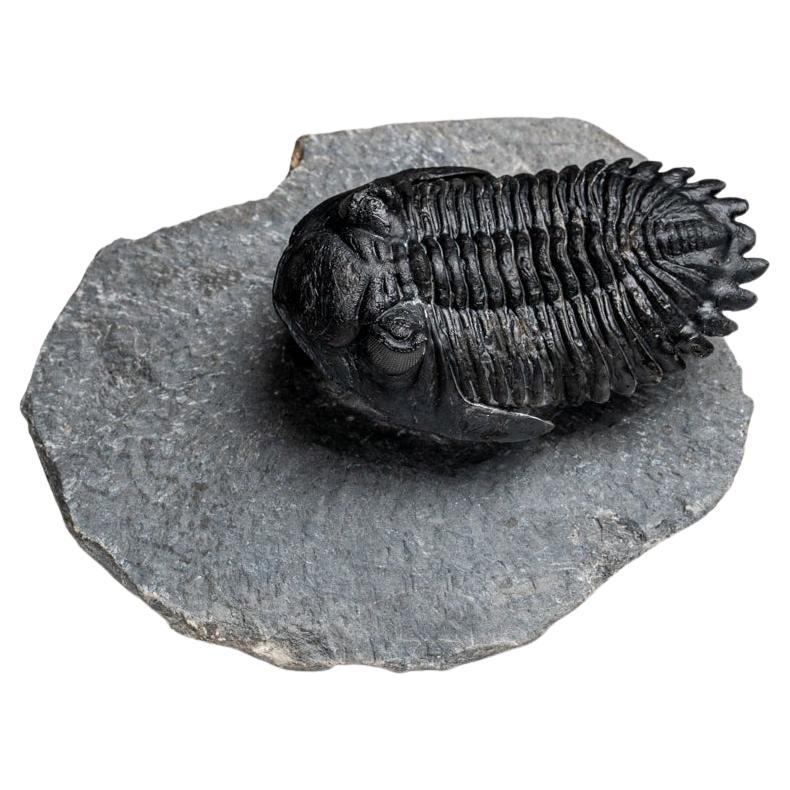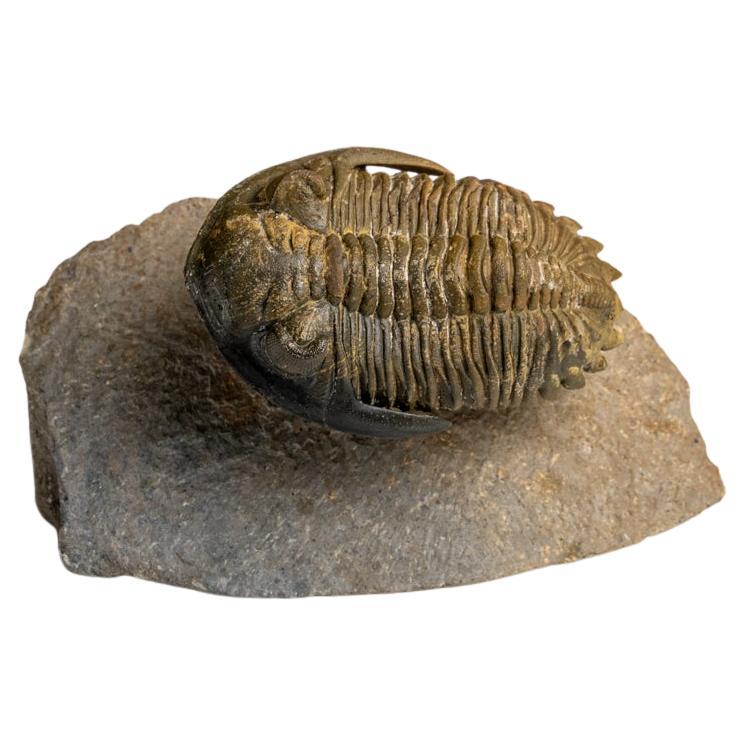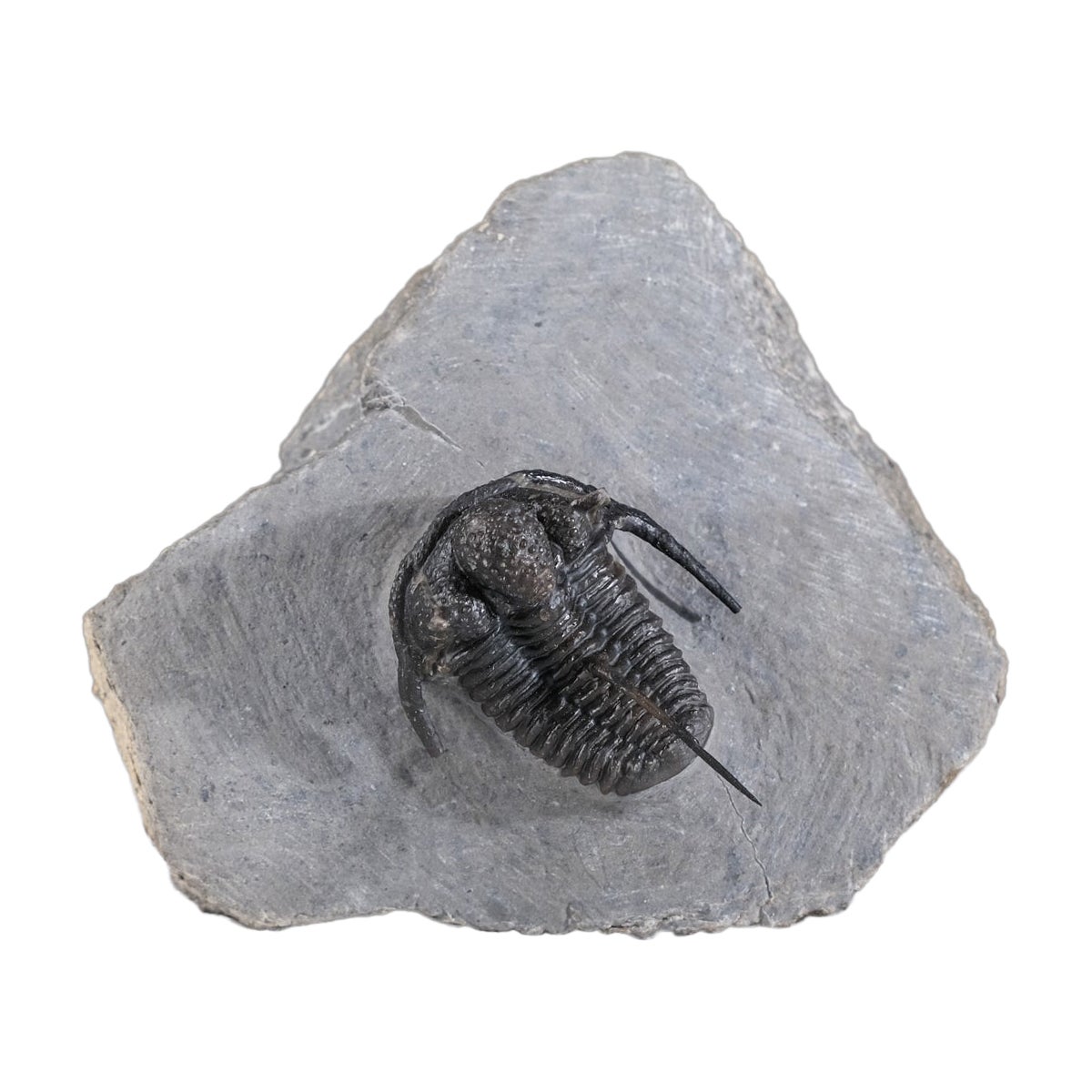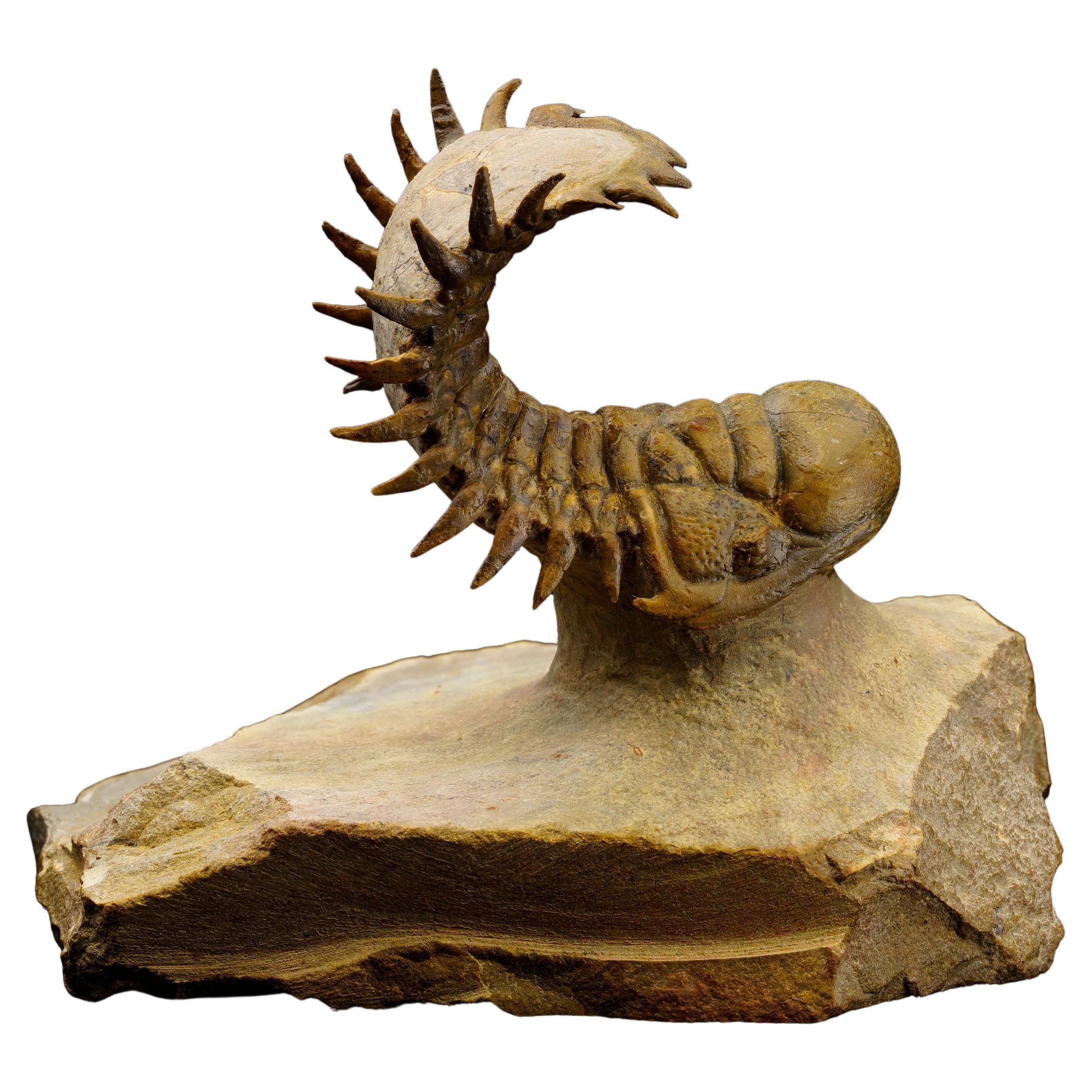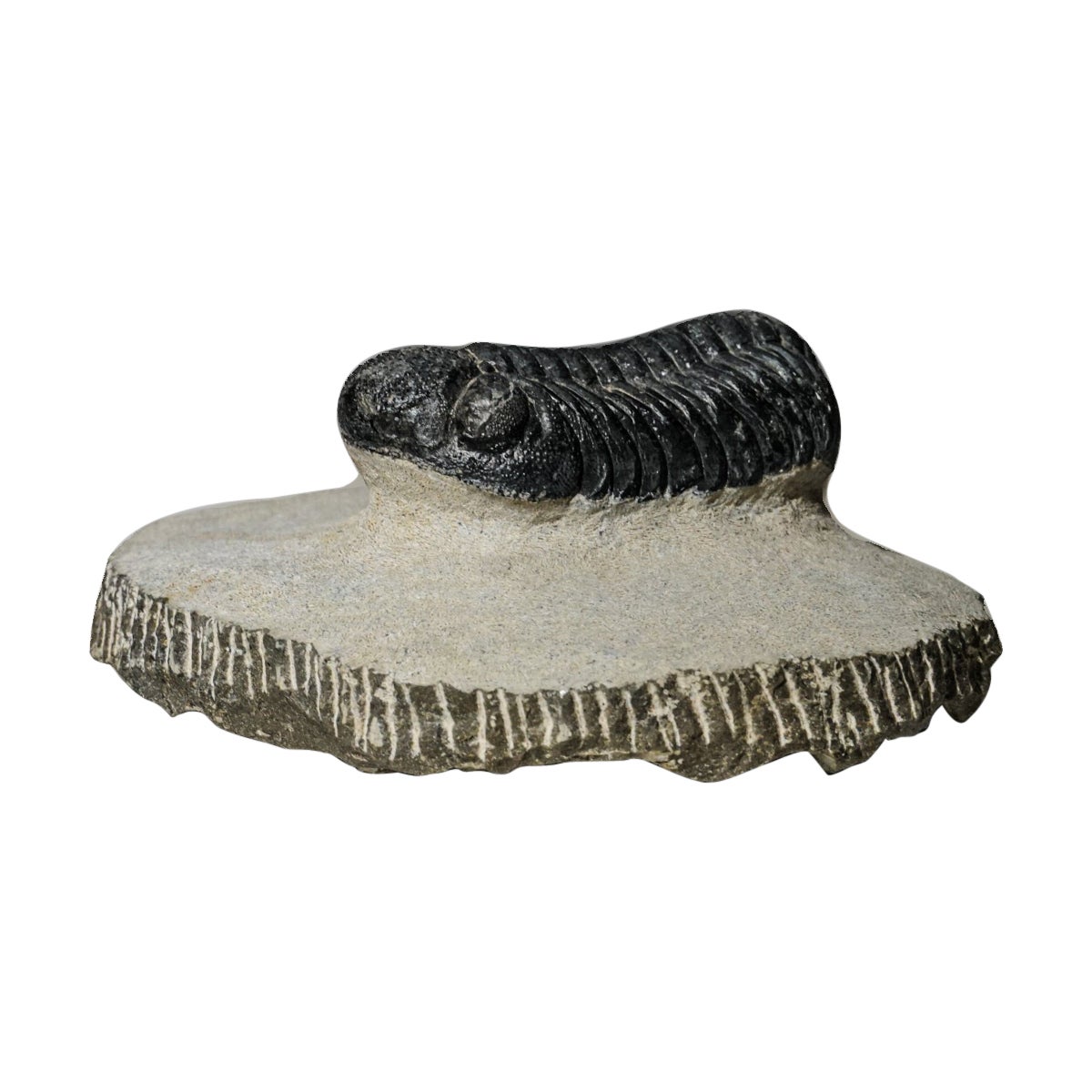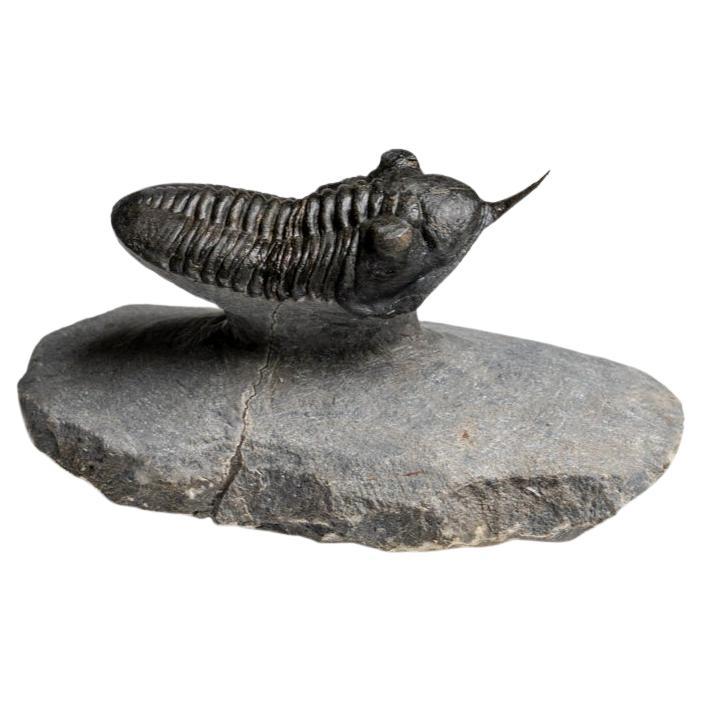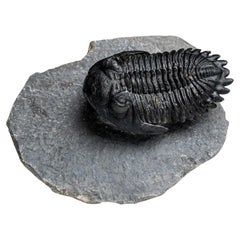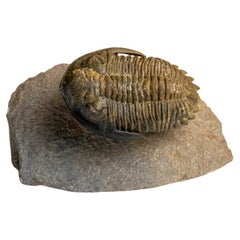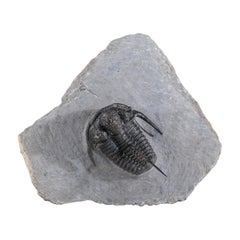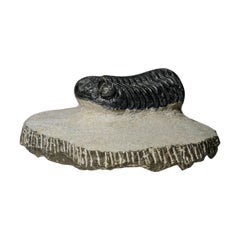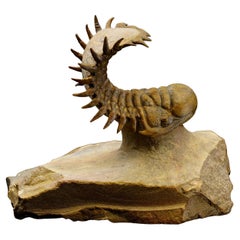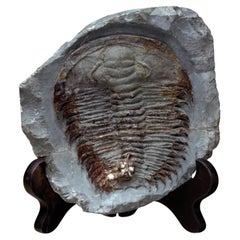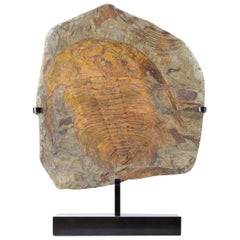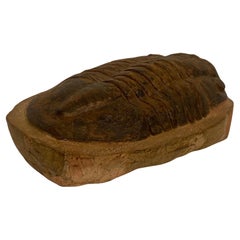Items Similar to Kolihapeltis chlupaci Trilobite from Djebel Oufaten, Morocco (154.5 grams)
Want more images or videos?
Request additional images or videos from the seller
1 of 10
Kolihapeltis chlupaci Trilobite from Djebel Oufaten, Morocco (154.5 grams)
$750
£568.61
€656.87
CA$1,061.86
A$1,191.21
CHF 615.89
MX$14,366.63
NOK 7,835.41
SEK 7,338.61
DKK 4,902.47
About the Item
Kolihapeltis chlupaci hollardi is a rare, spiny trilobite fossil, a member of the Order Corynexochida and Family Scutellidae, found in the Lhandar Formation near Atchana, Morocco, during the Lower Devonian (Pragian Stage).
Trilobites, an early arthropod relative of spiders, horseshoe crabs, and scorpions, preserved in this level of detail only occurred as a result of very sudden underwater landslides called turbidite sequences, which ravaged the early earth when the continents were still very much on the move. The contorted body positions of the trilobites demonstrate a final fight against being buried alive.
Species: Kolihapeltis chlupaci Trilobite
Location: Djbel Ougrat, Morocco
Weight: 154.5 lbs, Size: 3 x 2 x 1.5 inches
- Dimensions:Height: 3.75 in (9.53 cm)Width: 2 in (5.08 cm)Depth: 4 in (10.16 cm)
- Materials and Techniques:
- Place of Origin:
- Period:
- Date of Manufacture:21st Century
- Condition:Wear consistent with age and use.
- Seller Location:New York, NY
- Reference Number:Seller: TRI-611stDibs: LU6682244369192
About the Seller
3.9
Vetted Professional Seller
Every seller passes strict standards for authenticity and reliability
Established in 1961
1stDibs seller since 2022
110 sales on 1stDibs
Typical response time: 1 hour
- ShippingRetrieving quote...Shipping from: New York, NY
- Return Policy
Authenticity Guarantee
In the unlikely event there’s an issue with an item’s authenticity, contact us within 1 year for a full refund. DetailsMoney-Back Guarantee
If your item is not as described, is damaged in transit, or does not arrive, contact us within 7 days for a full refund. Details24-Hour Cancellation
You have a 24-hour grace period in which to reconsider your purchase, with no questions asked.Vetted Professional Sellers
Our world-class sellers must adhere to strict standards for service and quality, maintaining the integrity of our listings.Price-Match Guarantee
If you find that a seller listed the same item for a lower price elsewhere, we’ll match it.Trusted Global Delivery
Our best-in-class carrier network provides specialized shipping options worldwide, including custom delivery.More From This Seller
View AllGenuine Hollardops Trilobite Fossil from Ofaten, Morocco (170.6 grams)
Located in New York, NY
Trilobites, an early arthropod relative of spiders, horseshoe crabs, and scorpions, preserved in this level of detail only occurred as a result of very sudden underwater landslides c...
Category
Antique 15th Century and Earlier Moroccan Natural Specimens
Materials
Cement, Other
Genuine Hollardops Trilobite Fossil from Ofaten, Morocco (261.3 grams)
Located in New York, NY
Trilobites, an early arthropod relative of spiders, horseshoe crabs, and scorpions, preserved in this level of detail only occurred as a result of very sudden underwater landslides c...
Category
Antique 15th Century and Earlier Moroccan Natural Specimens
Materials
Cement, Other
Ceratarges armatus Trilobite from Morocco (186 grams)
Located in New York, NY
Trilobites, an early arthropod relative of spiders, horseshoe crabs, and scorpions, preserved in this level of detail only occurred as a result of very sudden underwater landslides called turbidite sequences, which ravaged the early earth when the continents were still very much on the move. The contorted body positions of the trilobites demonstrate a final fight against being buried alive.
This is an extremely ornamented member of the trilobites' extremely well-known and globally distributed Lichid family. These trilobites have adapted for extreme defensiveness. Their long genal appendages afford them controlled escape from the water column...
Category
Antique 15th Century and Earlier Moroccan Natural Specimens
Materials
Cement, Other
Genuine Asaphus intermedius Trilobite in Matrix from Morocco (341 grams)
Located in New York, NY
Large, natural trilobite in its original fossil matrix. The Asaphid trilobites include some of the most extreme trilobite adaptations known, and the group produced some of the larges...
Category
Antique 15th Century and Earlier Moroccan Natural Specimens
Materials
Cement, Other
Phacopid (Morocconites Malladoides) Trilobite from Morocco (276.2 grams)
Located in New York, NY
Here is one of the more unusual species of trilobites, a Morocconites malladoides from the Devonian of Morocco. It's a member of the Phacopida trilobites and has a very defining feat...
Category
Antique 15th Century and Earlier Moroccan Natural Specimens
Materials
Cement, Other
Genuine Trilobite Fossil (Ptychopariida) on Matrix (387.3 grams)
Located in New York, NY
Ptychopariida is a large, heterogeneous order of trilobite containing some of the most primitive species known. The earliest species occurred in the second half of the Lower Cambrian...
Category
21st Century and Contemporary Natural Specimens
Materials
Cement, Other
You May Also Like
Crotacephalina Trilobite From Morocco
Located in New York, NY
Add a dramatic piece of natural history to your collection with this beautifully preserved Crotalocephalina gibba trilobite from the Lower Devonian period, approximately 400 million ...
Category
Antique 15th Century and Earlier Moroccan Natural Specimens
Materials
Limestone, Other
$1,875 Sale Price
25% Off
Paradoxides Trilobite Fossil
Located in New York, NY
This Paradoxides trilobite specimen presented as-unearthed in matrix dates back over 499 million years to the Middle Cambrian Epoch. Paradoxides is one of the earliest known genus of...
Category
Antique 15th Century and Earlier Asian Natural Specimens
Materials
Other
Fossil Paradoxides Acadoparadoxides Trilobite Surmounted Bronze stand
Located in Scorton, GB
THE FOSSIL STORE™ is a unique 1.3-meter-long Paradoxides acadoparadoxides trilobite plate of scientific significance. The one-piece fossil bed shale is now set into a rustic iron fra...
Category
Antique 15th Century and Earlier North African Prehistoric Natural Speci...
Materials
Limestone, Iron
A Trilobite Fossil
Located in Schellebelle, BE
A Trilobite fossil from Morocco,great patina and shine of the fossilized stone,
Trilobits are extinct marine arthropods,easily recognized by their distinctive
three-lobed, three-seg...
Category
Antique 15th Century and Earlier Moroccan Sculptures and Carvings
Materials
Ironstone
$1,306
FERMACHE WITH TRILOBITE real fossil of the Paleozoic Era to admire and use #2
By Nino Basso, Design Center 1991
Located in Spilimbergo, IT
On a basis in polished metal lies a magnificent fossil of genuine trilobite that seems to rest on top of a rock. Today, this exceptional marine organism lived millions of years ago...
Category
Early 2000s Italian Modern Paperweights
Materials
Stone, Brass
Rare Fossil Trilobite Tracks Surmounted Etched Brass Stand
Located in Scorton, GB
A rare and fine Devonian Ichnofossil trilobite plate raised on a custom-fitted brass removal mount. The Saharan rock plate has been entirely and attractively weather-worn, with the n...
Category
Antique 15th Century and Earlier North African Prehistoric Natural Speci...
Materials
Limestone, Brass
